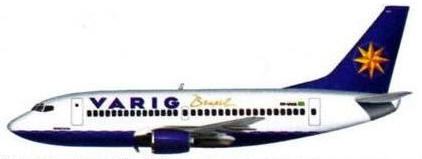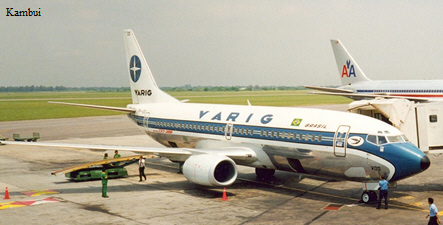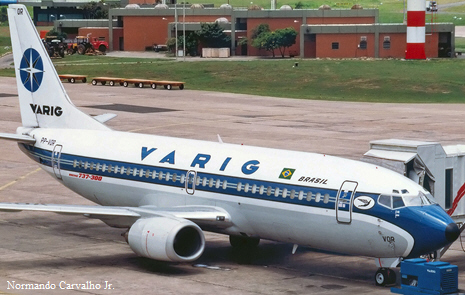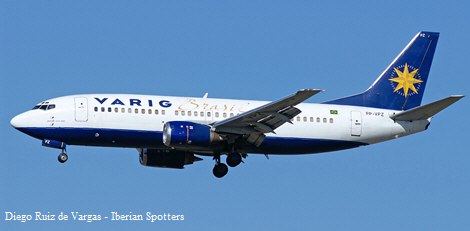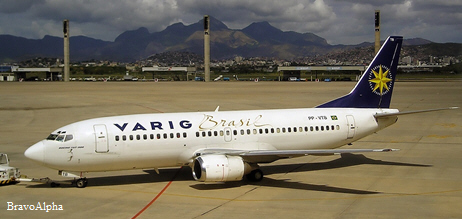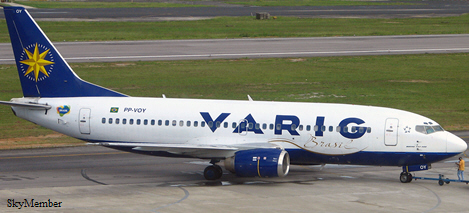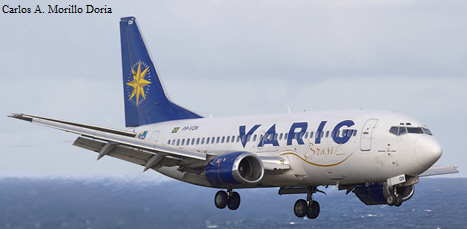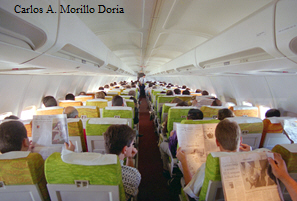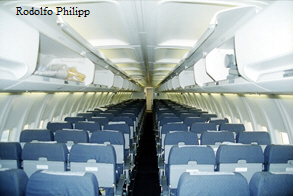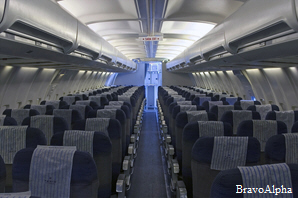|
AIRCRAFT |
|||||||
|
The Boeing 737-300 is B737-200 successor and incorporates new technologies and aerodynamic refinements, in addition to more powerful and economical engines. In September 1987 VARIG received the first two units, PP-VNU and PP-VNV. Still in 1987, VARIG received two more units, PP-VNT and PP-VNX, in November. Initially B737-300 began their career at VARIG on domestic routes, together with Boeing 727-100 and Boeing 737-200.
In November 1988 PP-VOD arrived
and in December PP-VOE. In 1989, the company received more four
units, the last, received in October (PP-VOM), was the first not to
be delivered directly from the factory. It had previously been
operated by Hispania Airlines.
In 1990 VARIG received more five units, one (PP-VOR) used, totaling
fifteen units in the fleet. From the 1990s, Boeing 737-300 became
VARIG's main aircraft for domestic and international flights in
South America. Initially, B737-300 were configured with 117 seats in
two classes: Business and Economy. Then the company adopted two
configurations: 120 passengers in two classes and 132 passengers in
a single class. During the 1990s, Boeing 737-300 gradually replaced
Boeing 727-100 and then Boeing 737-200.
In 1991 VARIG received more eight Boeing 737-300 and more three in
1992, totaling twenty-six units in the fleet. In 1991 Boeing 737-300
became the aircraft with the largest units in the fleet. In 1992
they replaced the legendary Electra II on Rio - São Paulo "Air
Bridge". With the introduction of B737, the travel time between Rio
de Janeiro and São Paulo was reduced by about 10 minutes and the
airlines pool were able to increase the seat offer by around 70%. To
allow a safe landing, Santos Dumont Airport runway, in Rio de
Janeiro, was increased by 300 meters. After Electra II retirement,
VARIG fleet was 100% jet aircraft. At that time Boeing 737-300 could
be seen in practically all cities served by VARIG in Brazil, in
addition to Montevideo, Buenos Aires, Asunción, Santa Cruz de La
Sierra and La Paz.
Until 1997, VARIG did not receive
new units. However, in April 1995 it returned PP-VOM. To replace the
remaining Boeing 737-200s, VARIG started receiving a new order of
Boeing 737-300. Five units arrived in 1997 (one used) and more four
in 1998 (two used). However, PP-VOX was returned in November 1998.
As a result, the Boeing 737-300 fleet remained on thirty-four
aircraft.
In 1998 VARIG received its first Boeing 737-700, from Boeing 737
third generation and a natural replacement for Boeing 737-300. The
intention was to gradually replace the Boeing 737-300 with B737NG.
In 1999 two Boeing 737-300 were returned, being replaced by new
Boeing 737-700.
However, the financial crisis faced by VARIG changed plans. Unable
to order new Boeing 737NGs, VARIG started to purchase more
second-hand Boeing 737-300s. In 2000, VARIG received three units,
two in 2001, five in 2002, two in 2003 and two in 2005. In 2001
Boeing 737-300 fleet achieved the peak, with thirty-seven units
operated simultaneously. Considering the Boeing 737-300 operated by
Rio Sul and Nordeste, there were 41 Boeing 737-300 operated
simultaneously. In 2003/2004 VARIG decided to merge with Rio Sul and
Nordeste, and started to operate the Boeing 737-300 previously
operated by its regional subsidiaries.
The Boeing 737-300 accompanied VARIG until the end of its operations
in 2006. However, over the years the fleet has been reduced. VARIG
returned four units in 2002 and ten units in 2003. In 2005 more two
units were returned, remaning twenty-one units in VARIG's fleet.
VARIG's Boeing 737-300 internal configuration:
1st: 117 seats
Business Class: 12 seats (2+2 seats per row)
Economy Class: 105 seats (3+3 seats per row)
2nd: 118 seats
Business Class: 16 seats (2+2 seats per row)
Economy Class: 102 seats (3+3 seats per row)

3rd: 120 seats
Business Class: 12 seats (2+2 seats per row)
Economy Class: 108 seats (3+3 seats per row)

4th: 128 seats
Business Class: 8 seats (2+2 seats per row)
Economy Class: 120 seats (3+3 seats per row)

5th: 132 seats (Economy Class only)

6th: 136 seats (Economy Class only)

| No. of units operated | 31 |
| Constructor | The Boeing Company, EUA |
| Engines | Two General Electric/SNECMA CFM-56-3B2, 22.000 pounds each |
| Wingspan | 28,90m |
| Length | 33,40m |
| Height | 11,10m |
| Cruising Speed | 850Km/h |
| Range | 3.600Km |
| Maximum flight altitude | 11.300m |
| Empty weight | 32.000Kg |
| Maximum takeoff weight | 61.235Kg |
| Technical crew | 02 (2 pilots) |
| Maximum Capacity | 149 passengers |
| Maximum Capacity ( VARIG configuration) | 117-132 passengers |
| Maximum fuel capacity | 20.100 liters |
| Minimum runway length | 1.9m |




